The Trash Surrounding Us
My brother metalmensch was sent to work in India a few years ago. Being my brother, he had his eye trained for things I, too, would find interesting, things beyond the travel brochure, things alien enough to folks like he and I that they verge on the outright fascinating.
He found such fascination in . . . trash cans. They weren't ordinary trash cans, no sirree. Check out one such can:
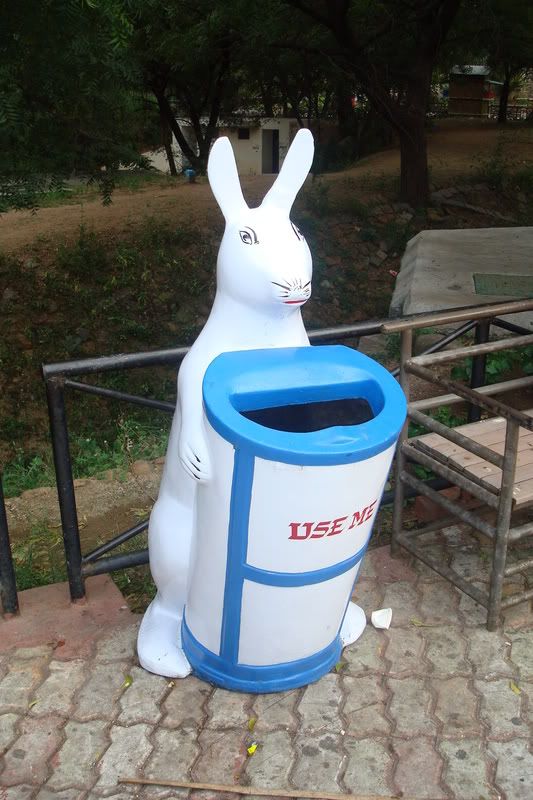
Litter can in Ramoji Studios
A few details simply must be noted. First, his Indian friends consider these cans "fiercely" embarrassing. That he was constantly shooting pictures of them in scenic areas like Ramoji Studios and the Taj Mahal was even worse. Shouldn't he be taking pictures of things worth viewing? Details of Indian life that might put the sub-continent in a pleasing light?
I'll get to why his friends thought his actions embarrassing in a bit. Right now, though, I'd like to share some podcast material that illustrates why I think we in the United States might have even more reason to feel fierce embarrassment: Simply, many of our buildings and neighborhoods are just as freakish and ugly as these cans are to the Indian locals.
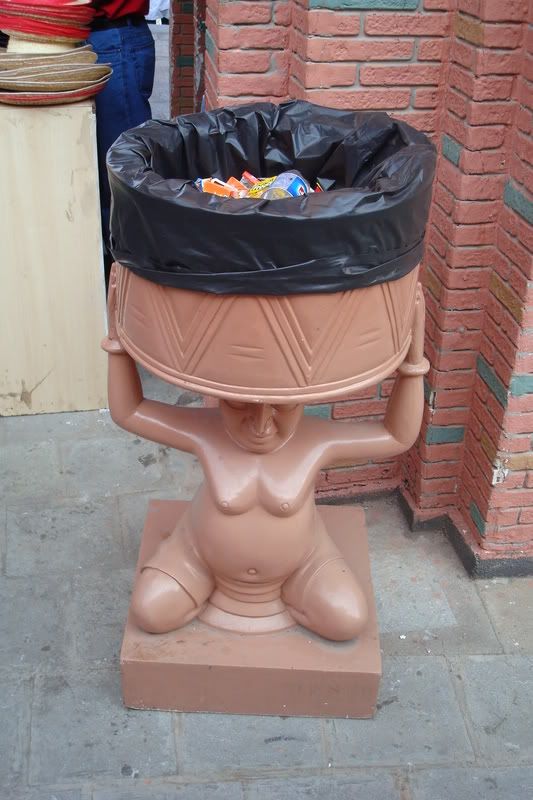
One of the "less disturbing" dustbins at Ramoji.
Let's start our aesthetic tour of American embarrassments with my favorite architectural curmudgeon, James Howard Kunstler. In his KunstlerCast #78 -- Litter and Pollution, he shares an experience from Germany:
I had a very vivid experience in Berlin about ten years ago. Somebody had directed me to go to take a look at a particular building on what had been the East Side of the Berlin Wall, the communist side. It was (an) apartment building designed by Peter Eiseman. . . . Berlin's a fairly tidy city. It's German, right? (In a German accent) ". . . . You vill follow zee orders! You vill be neat! You vill not drop zee litter!"
So I went over to the Friedrichstrase to see this building, and I noticed there was trash in all the light wells and around the various parts of the building, where there was no trash anywhere else on the sidewalk in front of any of the other buildings in Berlin. One of the things I concluded from that was that people will literally trash a place that they don't respect, or they don't like, or they object to. And people objected to this apartment building. It was not a handsome building. Y'know, it was a Peter Eiseman post-modernist special.
I was later told that this building -- in a city where apartments were really scarce and (commanded) a real premium -- I was told that this was the only apartment building that had a waiting list to get out of. So you could tell that people had a low regard for it.
So if people have a low regard for a public place, they'll treat it badly. A lot of American urban space is very difficult to have a high regard for. To some extent, a lot of it -- especially now after it's incurred all the damage of the post-war period -- these are places that you can almost categorically state that they're not worthy of our affection. They're unlovable. And people treat them like unlovable places. (Transcript and emphasis mine.)
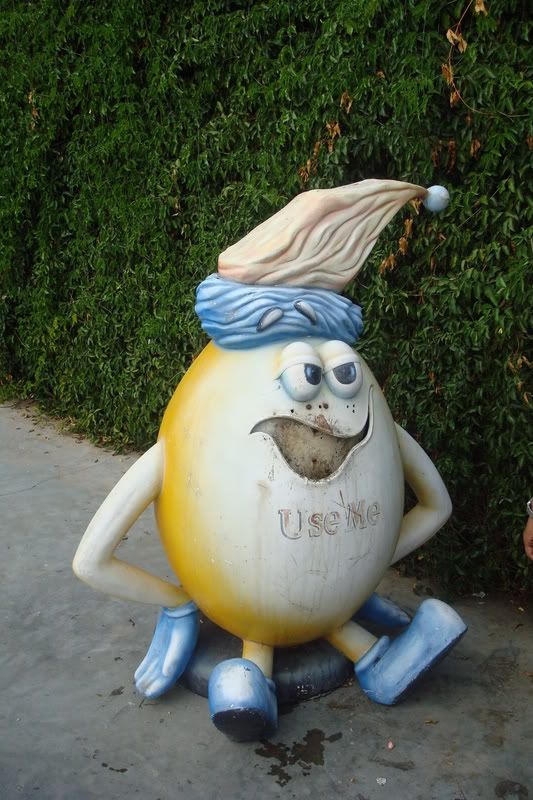
That sentence of Jim's I emphasized is not the reason Ramoji Studios has turned the elven-capped M&M Mars Peanut M&M character into a filthy trash receptacle. (Actually, remember the old M&Ms ad campaign, "Melts in your mouth, not in your hands?" That dustbin almost looks like he's been eating un-candy-coated chocolate like a three-year-old, smearing it all over his pie -- er, trash-hole. This leads me to believe M&M Mars did not authorize this reproduction, and would not be pleased to learn of its existence.
(But I digress.)
Ramoji Studios sounds like Universal Studios as far as attractions are concerned, probably not a repository of ugly architecture. Mr. Kunstler is instead emphasizing that the eastern portion of Berlin has an embarrassing building, a building most occupants want to leave if at all possible.
I did a little quick research on this Eiseman fellow. I love this quote from the Wiki entry on him: "Eisenman's focus on 'liberating' architectural form was notable from an academic and theoretical standpoint but resulted in structures that were both badly built and hostile to users." Yes, sounds just like that apartment Kunstler described. Ah, but the entry gets even more bizarre:
It was frequently repeated that (one of his building's) colliding planes tended to make its users disoriented to the point of physical nausea; in 1997 researcher Michael Pollan tracked the source of this rumor back to Eisenman himself. In the words of Andrew Ballantyne, "By some scale of values he was actually enhancing the reputation of his building by letting it be known that it was hostile to humanity." (Emphasis mine.)
This man Eiseman took pride in his building's hostility to humanity. Sound familiar? Regular Peristalt-ic readers should remember my and Kunstler's opinion on starchitecture, the aggrandizement of certain building designers based not on the way their designs interact well with the surroundings, but the way they deliberately confront and confound our innate human need for buildings to follow an aesthetic language of design.
How incredibly perverse of them.
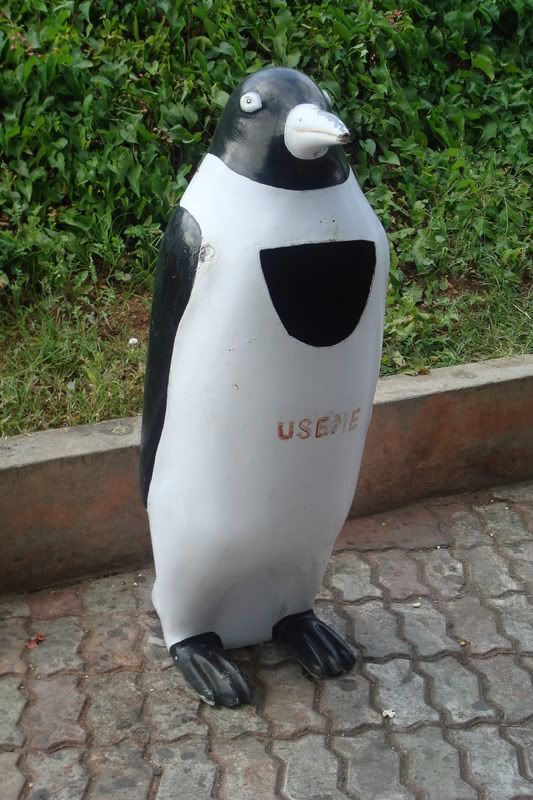
Ramoji Studio penguin bin.
While Kunster notes people's trashy protest of ugly architecture, Oscar Wilde took the overall effects quite a bit further. Another good (but infrequent) podcaster is Stephen Fry. If you don't know who he is, remedy that immediately. In his third podcast in his first Series of podcasts (transcript here), he tells of Oscar Wilde's 1881 lecture tour of the United States. While speaking in Leadville, Colorado, someone asked him:
“Why, Mr. Wilde, do you think America is such a violent country?”
“I can tell you why,” he said. “It’s susceptible readily of an explanation. America is such a violent country because your wallpaper is so ugly.”
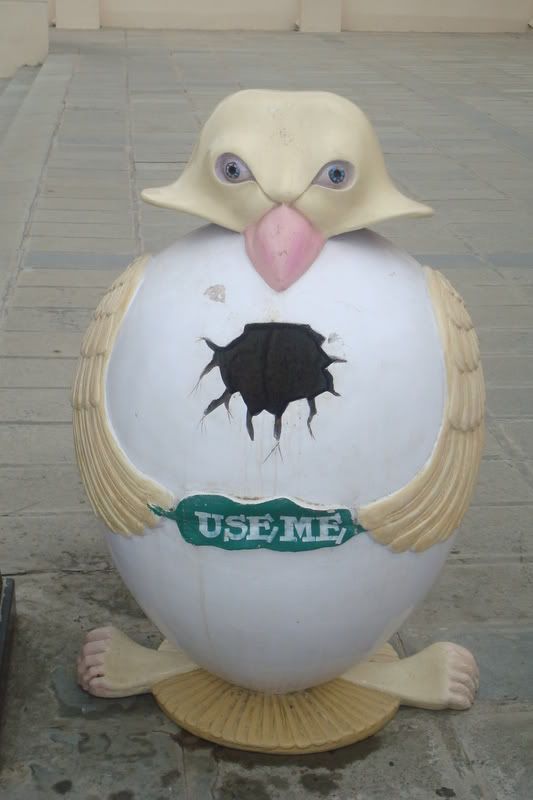
Now that seems, you might snort with laughter at first and say, “Well, how amusing.” Part you you may say, “Well this is just a typical peacocking primped camp remark from a shallow and trivial man who thinks it’s amusing to say things like that.”
But actually, to understand what the Aesthetic Movement is all about, one has to take that quite seriously. Instead of judging things as being good or bad, things are judged by whether they are beautiful or ugly. And we may say beauty is in the eye of the beholder, but actually it’s a lot easier to judge when things are beautiful than it is when things are bad or good. We spend our time puzzling dreadfully over whether we can interpret something as being wicked or whether it’s virtuous. However, beauty, beauty, beauty acts on us in a very real way, and what Wilde was partly saying was, if we look out of the window into our world, we see things that are universally and entirely beautiful from nature. Whether they be palm trees swaying in an island, whether they be the arctic wastes, whether they be deserts, tundra steps. It doesn’t matter where you look in the world, we see nothing but beauty. Unconditional, remarkable beauty.
Except where man has intervened.
And what Wilde is saying is, imagine belonging to a species where all you believe that all you can do to the world is to uglify it. To make it worse. To despoil it. Which is what we do. We know that now in real and profound and terrible ways that Wilde couldn’t have known about because the science hadn’t yet discovered quite how harmful we are as a species to our planet. But he could see that we were harmful to our planet in terms of its aesthetics. That we were making the earth uglier. Uglier with bad architecture, uglier with badly designed factories, uglier with badly stamped out tin trays and cheap ornaments, ugly with appalling wallpaper. And if you’re someone who grows up in such an environment, who is surrounded by badly made ugly things, then you think ugly thoughts of yourself and world. You think ugly thoughts of your whole species. There is nothing for you to do but to, to, to crap in your own nest. It’s what we do when we don’t believe in ourselves. (Emphasis boldly mine.)
America in Wilde's time -- indeed, a large part of America today -- is covered with such ugliness. In Berlin, they litter-ally trash bad buildings; in America, we have so many bad, ugly buildings we trash entire neighborhoods . . . and then we violently trash ourselves.
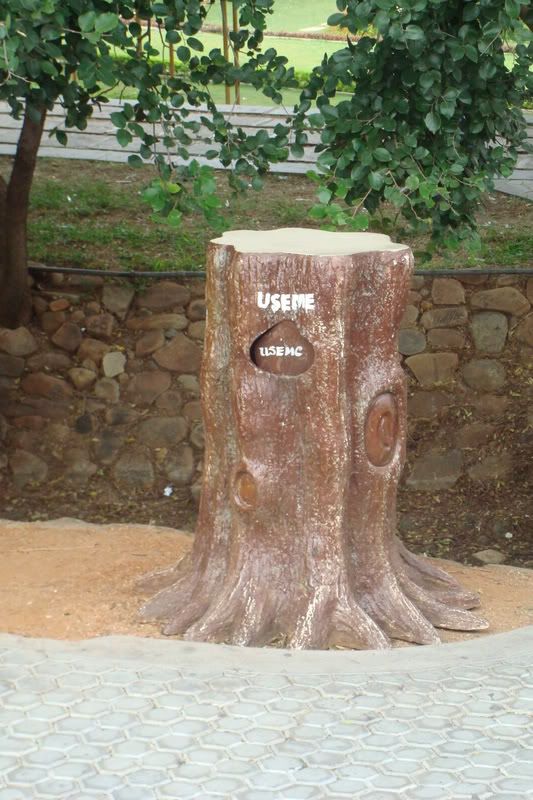
A bin so well camoflauged it was almost missed.
Now, finally, let's get to these damned dustbins. I'll let brother metalmensch testify:
Garbage cans are not something that are commonplace in India. What do you do with your trash? You drop any trash on the ground. Untouchables pick such things up and generally keep the place clean. Anything that can be picked up and burned will be by people who live on less a day than that latte you just bought and tried to find a trash can for.
To Indians, those bins are an embarrassing accusation. They exist exclusively for tourists who know nothing about how trash should be dealt with -- as a gift to people too unclean to gainfully employ, let alone touch. And since the cans exist for the tourists, the ubiquitous "Use Me" must be placed upon them to remind the locals that here the untouchables won't be doing their normal jobs (lest uncomfortable questions pop out of the tourist mouths).
Here in the US, we have trash cans a 'plenty. We also have bad, bad architecture in abundance, some buildings built to confound and confuse, some built to inspire nausea. Tourists point their cameras at these structures all the time, but often not to honor them. The strip malls of the country are undoubtedly snapped by folks as perverse as my brother and I, people who notice something very unusual, very disturbing. "Why does this string of four or five small businesses surround itself with parking tarmac like some kind of moat? Why not just put the buildings along the sidewalk like they do in Europe? By the way, where is the sidewalk? Does this mean you have to drive to get here? Damn. When the lot fills, where can one park? Nowhere?!? Really? Are Americans that bad at parallel parking? Wow. And why are the apartments so separate from the businesses? That makes no sense at all. I've got to get a picture."
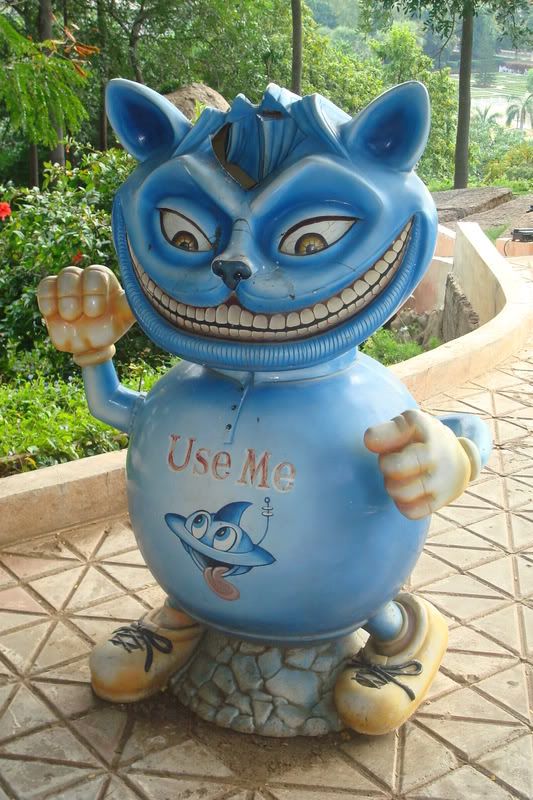
The Evil Cheshire Trash Cat
All cultures have elements other cultures simply can't understand. Without untouchables, we Westerners (well, most of us) simply cannot grasp an economic situation that turns a liability for society (accumulating garbage) into a resource donated to a subculture too vilified to even notice scrounging about.
By the same token, we Americans have become so enamored of personal vehicular transportation that we have destroyed the built environment for use by anything but, in some parts of the country so severely that we have relegated pedestrians and users of public transit to the same level as India's untouchables.
Built for the view from the street instead of the sidewalk, our buildings and their surroundings intimidate those forced to walk instead of drive. Those stuck without a car feel themselves stuck as in a tar pit, with all the opportunities reserved for the whimsically mobile. They live in apartment complexes surrounded by parking stalls and lawns on which no children play, far away from any social places like pubs, cafés and restaurants . . . and connected to these only by sidewalk-free county highways far too overbuilt to accommodate walkers safely, let alone peacefully.
And let's not forget that the cheap fuel that drives these neighborhoods is quickly but surely getting less and less abundant, a situation that will turn these areas into ugly and unusable. They will become tomorrow's Untouchable Places, hideous havens for those without the resources to remove themselves therefrom.

It's enough to inspire nightmares.
He found such fascination in . . . trash cans. They weren't ordinary trash cans, no sirree. Check out one such can:

Litter can in Ramoji Studios
A few details simply must be noted. First, his Indian friends consider these cans "fiercely" embarrassing. That he was constantly shooting pictures of them in scenic areas like Ramoji Studios and the Taj Mahal was even worse. Shouldn't he be taking pictures of things worth viewing? Details of Indian life that might put the sub-continent in a pleasing light?
I'll get to why his friends thought his actions embarrassing in a bit. Right now, though, I'd like to share some podcast material that illustrates why I think we in the United States might have even more reason to feel fierce embarrassment: Simply, many of our buildings and neighborhoods are just as freakish and ugly as these cans are to the Indian locals.

One of the "less disturbing" dustbins at Ramoji.
Let's start our aesthetic tour of American embarrassments with my favorite architectural curmudgeon, James Howard Kunstler. In his KunstlerCast #78 -- Litter and Pollution, he shares an experience from Germany:
I had a very vivid experience in Berlin about ten years ago. Somebody had directed me to go to take a look at a particular building on what had been the East Side of the Berlin Wall, the communist side. It was (an) apartment building designed by Peter Eiseman. . . . Berlin's a fairly tidy city. It's German, right? (In a German accent) ". . . . You vill follow zee orders! You vill be neat! You vill not drop zee litter!"
So I went over to the Friedrichstrase to see this building, and I noticed there was trash in all the light wells and around the various parts of the building, where there was no trash anywhere else on the sidewalk in front of any of the other buildings in Berlin. One of the things I concluded from that was that people will literally trash a place that they don't respect, or they don't like, or they object to. And people objected to this apartment building. It was not a handsome building. Y'know, it was a Peter Eiseman post-modernist special.
I was later told that this building -- in a city where apartments were really scarce and (commanded) a real premium -- I was told that this was the only apartment building that had a waiting list to get out of. So you could tell that people had a low regard for it.
So if people have a low regard for a public place, they'll treat it badly. A lot of American urban space is very difficult to have a high regard for. To some extent, a lot of it -- especially now after it's incurred all the damage of the post-war period -- these are places that you can almost categorically state that they're not worthy of our affection. They're unlovable. And people treat them like unlovable places. (Transcript and emphasis mine.)

That sentence of Jim's I emphasized is not the reason Ramoji Studios has turned the elven-capped M&M Mars Peanut M&M character into a filthy trash receptacle. (Actually, remember the old M&Ms ad campaign, "Melts in your mouth, not in your hands?" That dustbin almost looks like he's been eating un-candy-coated chocolate like a three-year-old, smearing it all over his pie -- er, trash-hole. This leads me to believe M&M Mars did not authorize this reproduction, and would not be pleased to learn of its existence.
(But I digress.)
Ramoji Studios sounds like Universal Studios as far as attractions are concerned, probably not a repository of ugly architecture. Mr. Kunstler is instead emphasizing that the eastern portion of Berlin has an embarrassing building, a building most occupants want to leave if at all possible.
I did a little quick research on this Eiseman fellow. I love this quote from the Wiki entry on him: "Eisenman's focus on 'liberating' architectural form was notable from an academic and theoretical standpoint but resulted in structures that were both badly built and hostile to users." Yes, sounds just like that apartment Kunstler described. Ah, but the entry gets even more bizarre:
It was frequently repeated that (one of his building's) colliding planes tended to make its users disoriented to the point of physical nausea; in 1997 researcher Michael Pollan tracked the source of this rumor back to Eisenman himself. In the words of Andrew Ballantyne, "By some scale of values he was actually enhancing the reputation of his building by letting it be known that it was hostile to humanity." (Emphasis mine.)
This man Eiseman took pride in his building's hostility to humanity. Sound familiar? Regular Peristalt-ic readers should remember my and Kunstler's opinion on starchitecture, the aggrandizement of certain building designers based not on the way their designs interact well with the surroundings, but the way they deliberately confront and confound our innate human need for buildings to follow an aesthetic language of design.
How incredibly perverse of them.

Ramoji Studio penguin bin.
While Kunster notes people's trashy protest of ugly architecture, Oscar Wilde took the overall effects quite a bit further. Another good (but infrequent) podcaster is Stephen Fry. If you don't know who he is, remedy that immediately. In his third podcast in his first Series of podcasts (transcript here), he tells of Oscar Wilde's 1881 lecture tour of the United States. While speaking in Leadville, Colorado, someone asked him:
“Why, Mr. Wilde, do you think America is such a violent country?”
“I can tell you why,” he said. “It’s susceptible readily of an explanation. America is such a violent country because your wallpaper is so ugly.”

Now that seems, you might snort with laughter at first and say, “Well, how amusing.” Part you you may say, “Well this is just a typical peacocking primped camp remark from a shallow and trivial man who thinks it’s amusing to say things like that.”
But actually, to understand what the Aesthetic Movement is all about, one has to take that quite seriously. Instead of judging things as being good or bad, things are judged by whether they are beautiful or ugly. And we may say beauty is in the eye of the beholder, but actually it’s a lot easier to judge when things are beautiful than it is when things are bad or good. We spend our time puzzling dreadfully over whether we can interpret something as being wicked or whether it’s virtuous. However, beauty, beauty, beauty acts on us in a very real way, and what Wilde was partly saying was, if we look out of the window into our world, we see things that are universally and entirely beautiful from nature. Whether they be palm trees swaying in an island, whether they be the arctic wastes, whether they be deserts, tundra steps. It doesn’t matter where you look in the world, we see nothing but beauty. Unconditional, remarkable beauty.
Except where man has intervened.
And what Wilde is saying is, imagine belonging to a species where all you believe that all you can do to the world is to uglify it. To make it worse. To despoil it. Which is what we do. We know that now in real and profound and terrible ways that Wilde couldn’t have known about because the science hadn’t yet discovered quite how harmful we are as a species to our planet. But he could see that we were harmful to our planet in terms of its aesthetics. That we were making the earth uglier. Uglier with bad architecture, uglier with badly designed factories, uglier with badly stamped out tin trays and cheap ornaments, ugly with appalling wallpaper. And if you’re someone who grows up in such an environment, who is surrounded by badly made ugly things, then you think ugly thoughts of yourself and world. You think ugly thoughts of your whole species. There is nothing for you to do but to, to, to crap in your own nest. It’s what we do when we don’t believe in ourselves. (Emphasis boldly mine.)
America in Wilde's time -- indeed, a large part of America today -- is covered with such ugliness. In Berlin, they litter-ally trash bad buildings; in America, we have so many bad, ugly buildings we trash entire neighborhoods . . . and then we violently trash ourselves.

A bin so well camoflauged it was almost missed.
Now, finally, let's get to these damned dustbins. I'll let brother metalmensch testify:
Garbage cans are not something that are commonplace in India. What do you do with your trash? You drop any trash on the ground. Untouchables pick such things up and generally keep the place clean. Anything that can be picked up and burned will be by people who live on less a day than that latte you just bought and tried to find a trash can for.
To Indians, those bins are an embarrassing accusation. They exist exclusively for tourists who know nothing about how trash should be dealt with -- as a gift to people too unclean to gainfully employ, let alone touch. And since the cans exist for the tourists, the ubiquitous "Use Me" must be placed upon them to remind the locals that here the untouchables won't be doing their normal jobs (lest uncomfortable questions pop out of the tourist mouths).
Here in the US, we have trash cans a 'plenty. We also have bad, bad architecture in abundance, some buildings built to confound and confuse, some built to inspire nausea. Tourists point their cameras at these structures all the time, but often not to honor them. The strip malls of the country are undoubtedly snapped by folks as perverse as my brother and I, people who notice something very unusual, very disturbing. "Why does this string of four or five small businesses surround itself with parking tarmac like some kind of moat? Why not just put the buildings along the sidewalk like they do in Europe? By the way, where is the sidewalk? Does this mean you have to drive to get here? Damn. When the lot fills, where can one park? Nowhere?!? Really? Are Americans that bad at parallel parking? Wow. And why are the apartments so separate from the businesses? That makes no sense at all. I've got to get a picture."

The Evil Cheshire Trash Cat
All cultures have elements other cultures simply can't understand. Without untouchables, we Westerners (well, most of us) simply cannot grasp an economic situation that turns a liability for society (accumulating garbage) into a resource donated to a subculture too vilified to even notice scrounging about.
By the same token, we Americans have become so enamored of personal vehicular transportation that we have destroyed the built environment for use by anything but, in some parts of the country so severely that we have relegated pedestrians and users of public transit to the same level as India's untouchables.
Built for the view from the street instead of the sidewalk, our buildings and their surroundings intimidate those forced to walk instead of drive. Those stuck without a car feel themselves stuck as in a tar pit, with all the opportunities reserved for the whimsically mobile. They live in apartment complexes surrounded by parking stalls and lawns on which no children play, far away from any social places like pubs, cafés and restaurants . . . and connected to these only by sidewalk-free county highways far too overbuilt to accommodate walkers safely, let alone peacefully.
And let's not forget that the cheap fuel that drives these neighborhoods is quickly but surely getting less and less abundant, a situation that will turn these areas into ugly and unusable. They will become tomorrow's Untouchable Places, hideous havens for those without the resources to remove themselves therefrom.

It's enough to inspire nightmares.